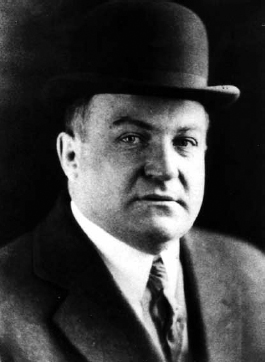
THE BLACK WIDOW
Love, tragedy, betrayal and retribution. Throw these things together, mix in millions of dollars and you have the perfect recipe for a ghost. Eden Park is known for its serene settings and panoramic views. It is an oasis for many looking to get away from everyday life. When the sun sets on this picturesque landscape, a much more sinister side is revealed. A ghost with a very unique story wanders these grounds looking for a peace that she may never find.
The dark and nearly unbelievable tale comes from a time when Cincinnati was at the peak of its golden era amid the 1920s. During Prohibition speakeasies flourished and bootleggers made millions. The story of one whiskey peddler in particular exemplifies the power that alcohol carried during the Prohibition era.
George Remus came from humble beginnings in Germany and would rise to be one of the most successful and powerful bootleggers this country has ever seen. George’s father, Franck Remus, came from Freideberg, Germany, near Berlin. Franck was an apprentice in a woolen mill and eventually married the mill owner’s daughter, Maria Karg, in 1871. They had three girls who all died in infancy. George Remus, their fourth child, was the only child who lived. When George was four and a half years old, he departed Germany with his parents for Milwaukee, Wisconsin, where several other members of the Karg family had previously settled.
After arriving in America, tragedy continued to strike the Remus family. The family fell on hard times almost immediately after settling in Milwaukee. Frank, who dropped the Germanic spelling of his first name after arriving in America, was no longer a weaver, but instead had been doing work as a lumber scorer. He became crippled with articular rheumatism and was no longer able to work. The family left for Chicago, where George would become the main provider for the family by his early teens. An uncle, George Karg, ran a drugstore in Chicago, and young George Remus left school to work as his assistant.

George Remus, “King of the Bootleggers.” Courtesy Jack Doll Collection, Delhi Historical Society.
According to everyone who knew George, he was a good and responsible young man. He loved books, had a great sense of humor and seldom had to be scolded. He became a strong swimmer and a well-known member of the Illinois Athletic Club’s water polo team. He was confirmed in the Lutheran Church, despite the fact that neither he nor his family was very religious. As he grew older, he was sufficiently curious enough about different churches to attend Catholic, Christian Science and Presbyterian services. Later in life, he was quoted as saying, “My religion is to pay my obligations and keep my word.”
By the time George was nineteen, he secured a bank loan and bought the drugstore from his uncle. He had also studied and became a licensed pharmacologist after lying about his age. Young George was able to buy a second pharmacy from his profits, and he became a certified optometrist. It wasn’t uncommon for someone to study and become licensed himself, because doctors were expensive and social security did not yet exist. He fell in love with his customer and neighbor Lillian Kraus, and the two soon had a daughter named Romola. George was barely in his twenties, but had a strong sense of responsibility. He was running two drugstores, providing services as an unlicensed doctor, writing prescriptions for glasses, raising a family and studying law at night.
When George was twenty-four, he opened his own law practice. He became a prominent divorce lawyer but specialized in criminal law and represented several Chicago labor unions. He spent much of his time defending the dark side of humanity, including those who committed crimes that he would later commit himself. Remus hired a legal secretary named Imogene Holmes. Imogene was part of a wealthy family, telling George that she came “from the top drawer.” George and Imogene had an affair that eventually led to the end of his first marriage. Remus divorced Lillian in 1917, but maintained a good relationship with her and their daughter Romola, who got along exceptionally well with her father.
When Prohibition hit Chicago in 1918, many bootleggers turned to Remus, whom they trusted, for legal representation. Underworld figures regularly visited Remus’s office at 167 North Clark Street, setting him on the beginning of his dark path. Remus’s dealings with members of organized crime were strictly business. He knew Al Capone only vaguely through his business dealings. As a criminal defense lawyer, he witnessed several of his clients executed in the electric chair. It was because of his attendance at these horrific events that he came out strongly against the death penalty. His advanced knowledge as a lawyer and pharmacist was the perfect concoction to aid his ambitious rise to wealth and power. If the perfect candidate to become a bootlegger ever existed, Remus was it. His rationale was that if gangsters of limited intelligence could make money bootlegging, then surely he could do better. George sold his law practice and moved with Imogene to Cincinnati.
Relocating to Cincinnati was a strategic and well-planned move since three-quarters of the country’s bonded whiskey was within three hundred miles of the city. After Prohibition became law, millions of gallons of whiskey sat in government warehouses and distilleries. With the entire country dry, whiskey certificates were easily and cheaply had. Remus began buying them up and soon was the largest owner of distilleries in the United States.
Using his skills as an attorney, Remus found a loophole in the Volstead Act, the very law instituting Prohibition. It would make him millions. He would buy distilleries and pharmacies and use government-approved certificates to sell liquor to himself for medicinal purposes. He would then hire men to hijack the shipments of his own liquor, which Remus would sell for a profit. A very small amount ever hit the pharmacy shelves as medicinal whiskey. Each case contained three gallons. Remus paid as little as $0.65 per case to remove whiskey from various warehouses. It would then sell for $80.00 or more per case. The operation was meticulously planned and brought in large sums of cash daily. Within a few months of Prohibition taking effect, Remus had set up more than a dozen drug companies to sell the liquor to and was depositing as much as $15,000.00 per day into banks. When one of his drug companies had removed enough liquor to catch the attention of law enforcement, he would simply close that company and open another. As time passed, the financial success of the business grew, as well as its cost.
George Remus was running a bootlegging empire of epic proportions, and it wasn’t cheap. At the height of his success, he had as many as three thousand well-paid and fiercely loyal employees on the payroll. They represented all walks of life, from the servants at his farm to many policemen and politicians. His bribery reached as far as the attorney general, whom he successfully bribed for $500,000. During one quarter in 1921, Remus deposited $2.7 million into one Cincinnati bank.
Remus was constantly seeking acceptance from the community in Cincinnati. He set out to accomplish this by buying a huge farm in Price Hill, the most affluent suburb at the time. The property at 825 Hermosa Avenue matched his legendary status, complete with a large, newly renovated mansion and several houses for his many servants, chauffeurs and their families. It also showcased fully landscaped gardens, a greenhouse, a carriage house and several racing thoroughbreds housed in a stable. In 1920, Remus spent roughly $750,000 to renovate and develop the land. In today’s money, the project would cost several million dollars.
George and Imogene were married in June 1920, and began hosting extravagant and elaborate parties at their new home. The mansion was nicknamed “the Marble Palace.” Guests visiting the mansion found many unique artifacts, such as statues and sculptures, a collection of rare books and paintings, a gold piano and an autograph from George Washington. The parties were legendary. Remus was known for slipping $ 100 bills underneath guests’ dinner plates. The Remuses hosted a party on March 21, 1921, to celebrate the completion of their new $100,000 Olympic-size indoor swimming pool where each guest received an engraved gold Elgin watch. On New Year’s Eve 1922, the Remuses outdid themselves. The exclusive guest list boasted one hundred well-connected couples. As a parting gift, the following morning the men were presented with diamond watches, and the women each received a new automobile. Similar parties continued, including a night when a fifteen-piece orchestra serenaded guests while Imogene, who was a talented swimmer, made an appearance in a water ballet. George and Imogene were well on their way to gaining the acceptance that they so dearly longed for.
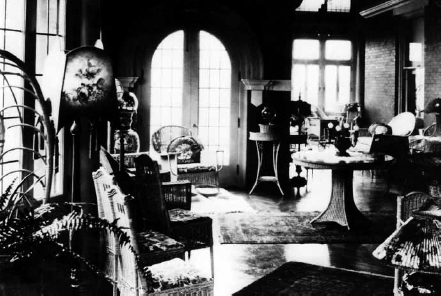
The solarium room at the Remus mansion. Courtesy Jack Doll Collection, Delhi Historical Society.
When Remus had bought his Price Hill mansion, he had also bought a property near Queen City Avenue called “Death Valley Farm.” This allowed him to increase the size of his operations in a hidden corner of the city near Westwood. Business was booming, but many forces were trying to take down George and his empire. Remus had a fleet of fifteen unmarked canvas-topped trucks he used for transport, and many times he used fruit and vegetables to conceal the cases of liquor. He also employed several heavily armed men to follow and protect the shipments since many gangs were on the lookout to hijack liquor. His extremely successful venture relied heavily on the large amounts of bribe money he paid. He estimated that during his heyday, he had spent $20 million on bribes.
There were only two men in the world, it seemed, that Remus could not bribe. They were the Prohibition directors for the states of Indiana and Kentucky, and they had made a special trip to Cincinnati to secretly raid Death Valley Farm. Through his large network of contacts throughout the community, George had heard that two strange men, possibly Prohibition agents, were in town. Early on that Sunday morning, Remus had sent a messenger from his Price Hill mansion down to Death Valley Farm to collect some money. He told the messenger to be sure to tell the men to clear out all of the liquor. The messenger collected the money but forgot to relay the message. Only hours later, the agents performed a raid on the farm. Remus and twelve of his men were charged and found guilty. Remus was sentenced to two years in jail and a $10,000 fine. For the first time all of the planning had failed. When Remus and his twelve associates departed Cincinnati for an Atlanta jail, they did it in style. Remus hired a special luxury train car that was attached to a regular train. Imogene accompanied her husband and the men on the trip while they enjoyed yet another party, with a private chef cooking gourmet meals.
While in jail, Remus continued to use his power to his advantage. He did his time in a separate building away from the general prison population called “Millionaire’s Row,” which was a small apartment with a private bathroom and kitchen. He had fresh flowers delivered daily. Imogene visited frequently, cooking and cleaning for George and sometimes spending the night. She had also made arrangements for George to make his time easier. For $1,000 per month, he was able to make unlimited phone calls, go outside of the jail on shopping trips and occasionally take Imogene out on the town in Atlanta, where they would spend the night in a hotel.
While in Atlanta, a friend of Remus told him of a very powerful and persuasive Prohibition agent named Franklin Dodge. With a successful bribe, Dodge had the power to possibly grant both of them a pardon. George sent Imogene to feel him out, telling her to get close to him and see what he was capable of. As she moved in and worked to bribe Dodge, she quickly fell in love with him. He was a notorious womanizer. Imogene had fallen deeply in love with one of the men whose job was to take down men like George. Imogene and Dodge began working together to strip Remus of his fortune. This proved an easy task since Imogene was left with power of attorney during George’s time in prison. The two systematically plotted Remus’s demise. Soon after starting their affair, Dodge quit his job with the Justice Department and moved into George’s Price Hill mansion. He used Remus’s personal items such as hats and cufflinks and slept in his bed. Imogene and Dodge also traveled frequently, often staying in a hotel as a married couple under an assumed name. Imogene gave Dodge $100,000 worth of George’s jewelry. She also sold one of George’s largest distilleries at a deep discount of $81,000 and sent him a check for $100 as his share. The two lovers even engaged in intimate acts in the warden’s office, only one hundred yards from where George was locked up. They filed papers alleging that George was an illegal alien because his father was never naturalized to try to get him deported. Remus sat in jail, deeply disturbed by the reports of dealings between Dodge and his wife.
Imogene had made up her mind that she wanted her husband to be locked up for as long as possible. When Remus was discharged from Atlanta, he faced an additional incarceration period of one year. Dodge had been one of the men responsible for Remus’s additional jail time, which he served in Troy, Ohio. Dodge sold a large portion of the whiskey permits that belonged to George and kept the money. He had even registered one of George’s cars in his own name, taken it to his hometown of Lansing, Michigan, and changed the plates. Imogene ranted to her family how she would somehow “take care of George,” even if it meant killing him. At the Troy jail, Remus was treated as a regular inmate for the first time. Upon hearing news of Imogene and Dodge’s deceitful actions, Remus had fits of rage inside his cell, breaking furniture and sobbing uncontrollably. He could not stand the thought of his wife and Dodge together. His empire, fortune and sanity were slowly melting away as he sat helplessly in his cell.
Each day George grew more despondent, having been thrust into a deeply depressed state. Finally the day of his release came. On April 26, 1927, George Remus was released from the Troy jail at midnight. He was driven home by his longtime friend, George Conners. Remus was looking forward to some relaxing back at home, far away from a jail cell. The two arrived at Remus’s Price Hill mansion about 4:00 a.m. What the two men found shocked them. All of the doors and windows were nailed shut, and George’s clothes were on the ground outside the back door. The men had to enter through a window into the mansion. An even more disparaging scene awaited them inside. All that remained of the mansion was a table, a few chairs, a gas range and sixty-three pairs of Imogene’s shoes. In his bedroom, Remus found a cot and a pair of men’s shoes that did not fit him. Imogene had stripped the mansion. There were no furnishings, chandeliers, paintings or sculptures. Imogene even had stonework removed from around the pool and sold. She had even taken Remus’s prized signed portrait of George Washington, his rare books and his equally rare collection of Washington letters. At the sight of the bare mansion, Remus fell to his knees and wept.
Shortly after his return home, Remus learned that his life was in danger from a reporter for the St. Louis Post Dispatch. Franklin Dodge had contacted some members of a gang in St. Louis called the Regan Rats and promised $ 15,000 if they would kill Remus. After learning of the news, Remus applied for and was granted a permit to carry a gun. At an Indianapolis railroad station George Conners spotted the gang and convinced Remus to catch the next train. Later it was learned that the gang intended on taking the train, staging a fight with Remus and killing him. It was also revealed that a contract had been taken out on George Conners’s life.
Fearing for his life, Remus became obsessed with his safety and would wander the grounds surrounding the mansion looking for imaginary men with a flashlight. He also told Conners that he would see hallucinations of Imogene and Dodge together. Eventually Remus and Conners moved out of the Price Hill mansion and into a suite at the Sinton hotel in downtown Cincinnati. Imogene continued ahead with the divorce, and Remus’s rage and despondency deepened. He went so far as attempting to throw Imogene’s lawyer out of a window during a deposition. The day before their divorce hearing, George received information that Imogene and her daughter Ruth were staying at the Alms Hotel in Walnut Hills. He waited outside for the two all day without success. Later that night, Remus had dinner with Conners, his driver George Klug and his secretary Blanche Watson. Remus then had Conners take him back to his Price Hill mansion to spend the night before the proceedings the following day. It would be the last time he would ever return to his once-prized estate.
The next day was Thursday, October 6, 1927. George and Imogene were due in the Hamilton County Domestic Relations Court that morning at 9:00 a.m. George Klug arrived at the mansion at 7:00 a.m. to drive Remus to the courthouse. Court records show that Remus asked Klug to first drive him to the Alms Hotel stating, “There is something I want to discuss with her before we go before the judge.” On Victory Parkway, near the hotel, Remus spotted Imogene and Ruth entering a taxicab and told Klug to catch the cab. Imogene spotted George and told her driver to hurry. Klug made a U-turn and a wild chase ensued. The chase crossed McMillan Street and continued toward Eden Park. Remus’s car forced the cab to the curb near the greenhouses in the park; he jumped out and began walking towards the cab screaming obscenities. Imogene then told the driver to go, and the cab sped away once again. The large car with Remus in the back overtook the cab again about one hundred feet north of the reservoir. Imogene’s daughter Ruth later testified that George pulled Imogene from the cab violently, shouting as he dragged her away. Imogene exclaimed, “For God’s sake don’t do it!” Ruth was close behind, yelling, “Daddy, what are you going to do?” Imogene screamed for help from the cab driver: “Steve, for God’s sake come help me!” She then ran back toward the cab. Remus went into a wild tirade, spouting profanities at Imogene as he caught her. The peaceful morning silence was broken as he held a gun to her abdomen and pulled the trigger. Imogene fell into the cab but quickly jumped back out the other side as Remus continued his pursuit. She ran away with her hands in the air screaming, “Won’t somebody save me-won’t somebody save me?”
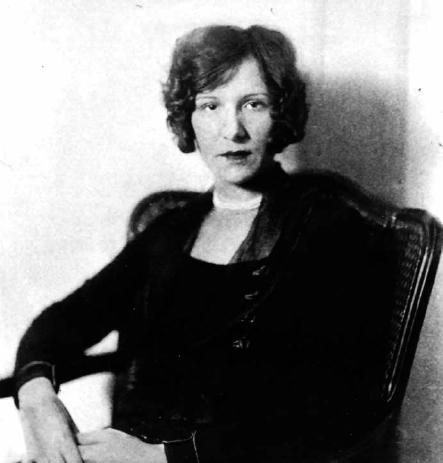
Ruth Remus, daughter of Imogene. Courtesy Jack Doll Collection, Delhi Historical Society.
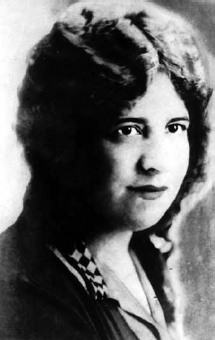
Imogene Remus, who was murdered in Eden Park. Courtesy Jack Doll Collection, Delhi Historical Society.
An automobile stopped and picked up Imogene, taking her to the hospital. Remus gave up his pursuit and threw his gun away as he ran out of the park. The gun was not found until years later when a child recovered it during an Easter egg hunt. Remus walked down Gilbert Avenue, where a driver offered him a ride. He was taken to the railroad station, where he then took a cab to city hall. Only thirty minutes after he shot Imogene, George Remus walked into the police station at city hall and surrendered.
The couple was scheduled to meet with Judge Dixon that morning. As he waited in his chambers, Imogene was fighting for her life. After an unsuccessful emergency surgery at Bethesda Hospital, Imogene was pronounced dead at 10:45 a.m. An autopsy revealed that the bullet entered her body just below the ribs. It then passed through the stomach, liver, diaphragm, spleen and left lung before lodging just under the skin on her back.
In the Hamilton County Jail, Remus received the special treatment to which he had become accustomed. He was given an extra cell to use as an office, had twenty suits with him to keep his appearance up, was allowed unlimited visitors and was even given liquor. The charge brought against Remus was first-degree murder. He faced the death penalty, a penalty he adamantly opposed but so willingly and coldheartedly bestowed upon his wife Imogene. Shortly before his trial was to begin, the bootlegger turned murderer decided that he would defend himself. He would plead not guilty by reason of insanity, a novel approach at that time. During the trial, he would claim that the terrible things done to him by his wife and her new lover, for more than two years, had systematically caused him to become insane. One of the prosecutors in the case was Charles Phelps Taft, who as mentioned in an earlier chapter resided in what is now the Taft Museum of Art.
The murder and ensuing trial captured the attention of the nation and shared headlines with Charles Lindbergh’s trip across the Atlantic. In the courtroom, Remus made jokes and was lighthearted. He had the benefit of being both popular and feared. He portrayed Imogene and Franklin Dodge as cold, self-involved characters who carefully calculated the takeover of his fortune and eventually his sanity. The jury was given the case on December 20. They reached their verdict in just two minutes, using a single ballot. After informing the judge that they had reached a verdict, the jury stayed out another three hours while enjoying a long lunch. When they reconvened, the jury foreman gave the verdict. The jury found Remus not guilty by reason of insanity. The Cincinnati Enquirer noted that the crowd in the courtroom cheered, and Remus shouted out, “That’s American justice!” Imogene’s family was appalled. A juror later said, “We felt, let’s go out and give him a Christmas present. He has been persecuted long enough.”
Remus was not guilty of murder but was not yet a free man. That night he hosted a party in his cell suite. His daughter Romola, a close circle of friends and two of the jurors celebrated with him. Remus was soon sent to a Lima insane asylum. Having lost, prosecutor Charles Phelps Taft worked tirelessly to have Remus committed to an insane asylum for life; however, the state’s whole murder case had centered on the fact that Remus was in fact sane. Since the state’s stance was that Remus was perfectly sane, he could not be confined to an insane asylum. He was eventually released from custody for good in June 1928.
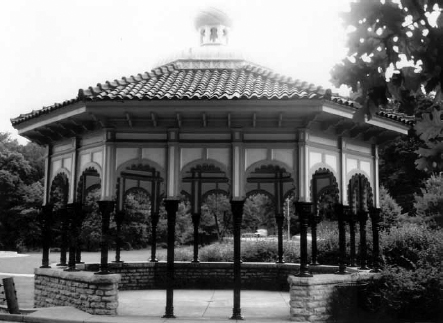
The gazebo where Imogene, the black widow, has been seen. Authors’ collection.
After being acquitted and released, Remus attempted to get back into the bootlegging business but found that it had been taken over by violent gangsters. He spent much of his time in Florida and later had a modest home in Covington, Kentucky, where he died in 1952.
In Eden Park, many people have seen a woman in a black dress in and around the gazebo near the mirror lake. When Imogene was gunned down, she was dressed in all black for her divorce date. She was wearing a black silk dress, black stockings and a black hat from Paris. Paranormal investigators have spent massive amounts of money and time trying to capture a glimpse of Imogene’s ghost. Some people experience cold spots or capture balls of energy on film in the gazebo. Others have reported seeing an apparition of Imogene in her black silk dress during early morning jogs. We have experienced her presence on more than one occasion. Her ghost seems to quietly roam the area and is quite curious about her visitors.
After living a lavish lifestyle, Imogene now resides in the beautiful park in which she lost her life. Her ghost seems content, seen by some gazing out of the gazebo onto the mirror lake. Shortly before George Remus went away to serve his term in Atlanta, he secured millions of dollars with friends and family and gave Imogene nearly his entire diamond collection, keeping just one for himself. The diamonds were never recovered. If you encounter Imogene’s ghost, be sure to ask her where the diamonds are.
HAUNTING ACTIVITY SCALE
Frequency*
Intensity**
Type: apparition